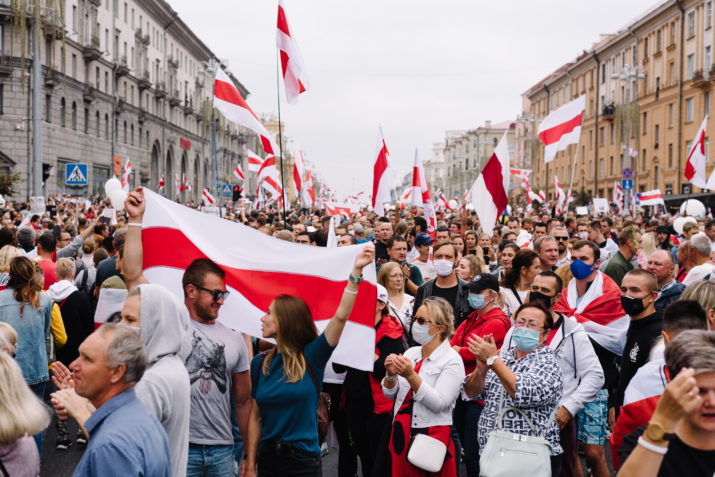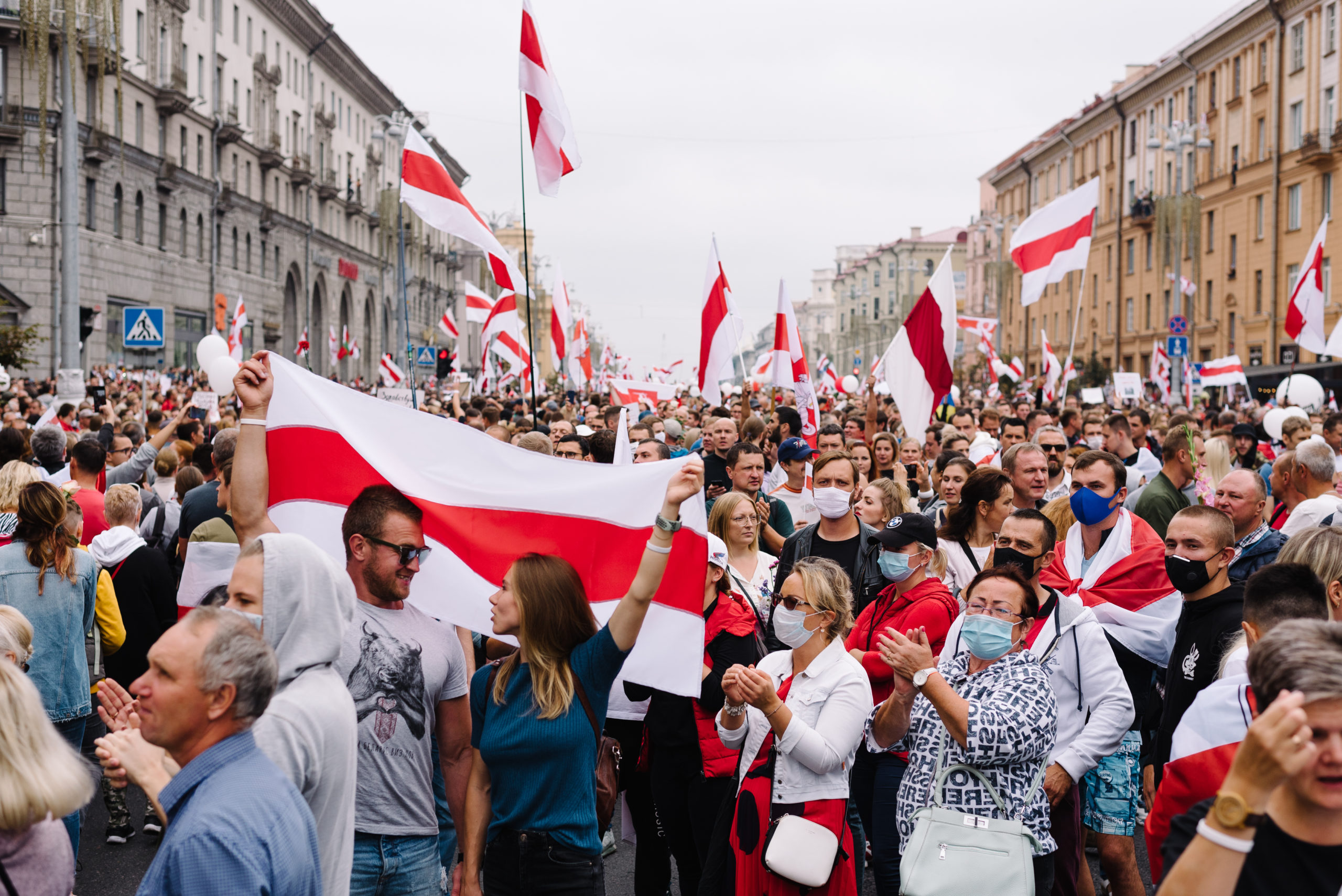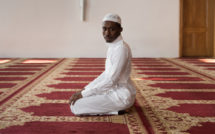

For nearly four months now, mass protests have rocked Belarus. Fall weather has not thinned the crowds demanding free and fair elections and the release of political prisoners. Women, pensioners, students, medics, workers, and software engineers—all cross-sections of Belarusian society—have participated. Several state enterprises went on strike in August, and after a lull, did so again in October. Protesters have been beaten, arrested, fined, and intimidated, even fired from their jobs, but they keep returning to the streets.
At stake is the rule of Alyaksandr Lukashenka, who has held his grip on power since 1994. Supported by the Kremlin, Belarus has gained notoriety as one of the most “stable” post-Soviet republics. Large swaths of the economy remain in state hands, and elections serve as affirmatory rituals for the incumbent. In 1995, through a referendum, Lukashenka even resurrected the country’s Soviet-era flag and coat of arms, albeit without the hammer and sickle.
Until this year, Belarusians stayed largely silent. Lukashenka’s expansion of presidential powers in 1997 drew just a few hundred protesters. The country’s largest protest, after the fraudulent 2010 election, gathered 40,000 people, but only for one day. There was a pervasive feeling that Lukashenka remained popular in some quarters, even though few doubted that the elections were rigged.
But now, Lukashenka’s rule has lost its aura of inevitability. What explains his remarkable resilience in the past and his sudden loss of legitimacy in 2020?
Lukashenka’s Resilience
Lukashenka has maintained power through an effective combination of economic stability, information control, and political repression.
Following the dissolution of the Soviet Union, he cultivated an image as a benevolent autocrat securing the steady improvement of livelihoods. Although Belarus did not undergo serious economic reform, GDP grew by 8-10 percent year until the 2008/2009 financial crisis.[1] Household income increased and inequality remained low. Pensions were paid on time, and healthcare and other social services remained affordable, albeit of low quality. Belarus scored well on the Human Development Index, outranking other post-Soviet states, and Lukashenka claimed this as his personal achievement.[2]
Many Belarusians work for the state in some form, and would remain loyal in exchange for job security and generous benefits. This social contract operated remarkably well, particularly for the generations that grew up in the Soviet Union, who dreaded economic instability and did not experience political freedoms firsthand. When an occasional bout of inflation or a sudden spike in gas prices forced people to tighten their belts, the state would allow them to vent their frustrations and try to satisfy their economic demands.
Lukashenka has been able to defy economic logic and maintain his part of the social contract thanks to the Kremlin’s generous subsidies. Belarus has imported Russian oil and gas at below-market rates and exported downstream petrochemical products to Europe. Each time the government’s finances run dry, Lukashenka turns to Russia for cheap credit in exchange for shares in Belarusian enterprises and promises of political loyalty.
Information control has also contributed to Lukashenka’s resilience. State TV delivers his message to households across the country, celebrating his economic achievements, warning of NATO threats, and lambasting the opposition, which receives no airtime of its own. The government routinely harasses independent media, accusing it of spreading false information, fomenting hatred, or threatening Belarus’s security. Independent newspapers remain accessible, but state-owned papers are cheaper and arrive in schools, offices, and libraries for free. Belarusians can see photos of Lukashenka visiting state farms harvesting wheat and potatoes, dancing with beautiful maidens, and projecting virility.
With the expansion of the Internet, Lukashenka introduced laws that authorize the government to shut down websites suspected of hurting the country’s “national interests.”[3] In the 2000s, Belarusians had to present their passports and IDs to use the Internet at coffee shops and Internet cafés. Independent websites were routinely blocked on election days, during currency crises, and at other inopportune moments for the regime. It remains easy to control the web today because all Internet traffic goes through just one state-owned company, Beltelecom.
Russian TV and newspapers are the main alternative to Belarusian state media, given the dominance of the Russian language. On several occasions, criticism of Lukashenka in Moscow has broken through to Belarusians. In the late 1990s, Boris Yeltsin seemed to be the only man capable of reining Lukashenka in. Russian media is no beacon of democracy under Vladimir Putin, but it can create trouble for Lukashenka when he becomes obstreperous. In 2010, Russia’s NTV broadcast “The Belarusian Godfather,” a documentary that exposed the “disappearances” of Lukashenka’s political opponents in 1999-2000 as well as his ties to Russian oligarch Boris Berezovsky and other unsavory figures. For the most part, however, Lukashenka’s crimes and economic mismanagement have remained hidden from Belarusians.
For a long time, this mix of relative economic stability and information control granted Lukashenka a veneer of legitimacy. Belarusians joked about the president in the safety of their kitchens, but without mobilizing politically. The opposition, meanwhile, was weak and divided. Indeed, a predictable pattern emerged: multiple opposition candidates traded barbs against each other ahead of the elections; most were jailed right after the vote and came out tarnished by rumors of collaborating with the KGB; and a new, equally divided cohort of opposition groups emerged by the time the next election rolled around.
The cycle of repression sowed disunity that discredited the opposition in the eyes of the general population. In 2006, two opposition coalitions, headed by Alexander Milinkevich and Alexander Kazulin, competed against one another. Both candidates were arrested, even though their “official” results were in the single digits. In 2010, nine opposition candidates contested the election and two additional candidates advocated boycotting the election, of whom seven ended up in jail. In 2015, the opposition was split between boycotting the election and supporting a single candidate, Tatsiana Karatkevich.[4]These feckless efforts caused Lukashenka little trouble.
Why 2020 Is Different
In this extraordinary year for the world, several factors have conspired to challenge Lukashenka more than ever before.
For one, his prevailing economic model is brittle. The collapse of oil prices has reduced Russia’s willingness to offer financial backing, and 2020 started with Moscow stopping oil deliveries to Minsk, costing millions in losses to the Belarusian budget. Tortuous negotiations ensued, and the two parties have reached only a temporary agreement.[5]
The COVID-19 pandemic made matters much worse. Lukashenka eschewed lockdowns and other preventive measures, against the advice of public health experts, in order to keep the economy running. But Belarus could not shield itself from the global downturn—by October 2020, state debt increased by 27 percent from the beginning of the year, while tax receipts in state and regional budgets shrank by 10.8 percent. And for the first time, Lukashenka offered no pre-election economic handouts to pensioners and large families.
Information control has also become less effective. Four out of every five Belarusians are now online, enabling the opposition to spread its message via YouTube and social networks. One of Lukashenka’s opponents in 2020, Sergei Tikhanovsky, rose to prominence by blogging about the hardships of ordinary people in remote towns and villages. Belarusians also used the Internet to monitor elections. Various online platforms, including Honest People, Zubr, Golos, asked voters to photograph their ballots and report irregularities. When the government shut down the Internet during the election in early August, 1.2 million out of 6.8 million eligible voters had registered their ballots—a remarkable amount of trust in independent civic initiatives in an authoritarian state.
With his control over the economy and information eroding, Lukashenka also made a series of tactical missteps. Foremost, he played fast and loose with COVID-19, not only failing to introduce preventive measures, but going so far as to dismiss the virus as a flu and recommending vodka and sauna treatments. Case counts kept rising, and Belarusians saw friends and relatives get sick. Many of those who died were misdiagnosed. Across the country, people began to self-organize to protect themselves and their families against the virus. The pandemic mobilized Belarus’s civil society more than any Western aid or training.[6] Internet crowdfunding became a popular organizational tool to pay for medical supplies and protective equipment, and would eventually be used to gather donations for Belarusians who lost their jobs for protesting against Lukashenka.
Lukashenka’s second mistake was to inadvertently unite the opposition. The 2020 campaign started out with the opposition divided as usual, as a record number of electoral committees (55) applied for registration.[7] Lukashenka nonetheless intervened to prevent the three most prominent candidates from running: Viktor Babariko and Sergey Tikhanovsky wound up in jail, and Valery Tsepkalo had to flee the country. By the August election, however, the opposition consolidated for the first time behind one candidate: Svetlana Tikhanovskaya, the wife of the jailed Tikhanovsky.
For Lukashenka, the stay-at-home mom Tikhanovskaya seemed a perfect foil. But her lack of experience actually struck a chord with ordinary Belarusians. She claimed she would rather cook for her children and stay out of politics but had to run for president out of desperation. Her main electoral promise was to secure free and fair elections as soon as possible, and she indicated no desire to assume power. The campaigns of the other two candidates, forced out of the race, did not hesitate to support her.
Finally, Lukashenka overplayed his hand after the vote. Immediately after the election, he claimed a baffling 80 percent of the vote, galvanizing people to take the streets. The crowds grew larger when the security forces unleashed disproportionate violence on the protesters and shut down the Internet.
In the past, repression affected only a small group of people, but in the three months since the election, thousands have experienced it firsthand. Even as state TV resumed broadcasts of a ripening harvest, people saw teargas, water cannons, and rubber bullets against peaceful protesters from their windows and balconies. Images of bruised bodies flooded Telegram, an encrypted communication platform that evaded Internet shutdowns and censorship.
A vital source of information for protesters has been NEXTA Live, a channel run by young Belarusian ex-pats living in Warsaw.[8] In the days after the election, its subscribers reached 1.2 million. NEXTA now stands at 1.8 million subscribers. Subsequently, more seasoned independent media, as well as the opposition candidate Svetlana Tikhanovskaya, have created their own Telegram channels. In a nod to Telegram’s success, state media have created their own channel on the platform.
What Happens Next?
During his twenty-six years in power, Lukashenka has created a strong and centralized state apparatus. The army, the police, and the nomenklatura continue to stand with him. He also remains the only person Putin can talk to, even though theirs is a marriage of convenience rather than true love. In September, Russia’s leader promised new loans, which also served as a symbolic victory for Lukashenka in his bid to reassure his allies inside the regime.
The current unrest could result in a more repressive regime, as Lukashenka resorts to more force, and works to sow divisions in the opposition, foment fears of western sabotage, and make cosmetic changes to the constitution.
Still, the regime Lukashenka built is at an inflection point. The incumbent has lost control over the narrative and Belarusians have acquired the know-how necessary for circumventing Internet shutdowns and censorship. The economy and the epidemic will only get worse in the coming months, reducing salaries for the security services and the many bureaucrats that form the backbone of the regime. The Kremlin seems to grow impatient with instability in Belarus and may be willing to back a different leader, provided the country’s geopolitical orientation remains unchanged.[9] The majority of the population views Lukashenka as an illegitimate leader. Previously apolitical, people are rapidly acquiring the skills and determination to effect change, and are forming networks that facilitate collective action. As the circle of repression widens, so does the number of Belarusians who view a return to pre-2020 apathy as unacceptable. Belarus, with its highly educated and increasingly affluent middle class, is ready for a turn to democracy.
Volha Charnysh is an Assistant Professor of Political Science at the Massachusetts Institute of Technology. Her research examines the aftermath of WWII and the politics of authoritarian regimes in Europe and Eurasia. She holds a PhD in Government from Harvard University and comes from Hrodna, Belarus. Follow her on Twitter @vcharnysh.
References:
[1] “GDP growth (annual %) – Belarus.” The World Bank, https://data.worldbank.org/indicator/NY.GDP.MKTP.KD.ZG?locations=BY
[2] Volha Charnysh. “Why Belarus Outranks CIS States on Human Development Index.” Belarus Digest, Nov. 2014, https://belarusdigest.com/story/why-belarus-outranks-cis-states-on-human-development-index/
[3] Volha Charnysh. “Belarus Tightens Media Control to Prepare for Election.” Belarus Digest, February 2015, https://belarusdigest.com/story/belarus-tightens-media-control-to-prepare-for-election/
[4] Aryom Shraibman. “Opposition Reshaping: Where will it lead?” Belarus Digest, January 2016, https://belarusdigest.com/story/opposition-reshaping-where-will-it-lead/
[5] “Is this the End of Russia-Belarus Oil Spat?” Warsaw Institute, March 2020, https://warsawinstitute.org/end-russia-belarus-oil-spat/
[6] Volha Charnysh. “The Unintended Consequences of the Pandemic on Belarus’ Presidential Elections.” Italian Instituttte for International Political Studies, August 2020, https://www.ispionline.it/en/pubblicazione/uninteded-consequences-pandemic-belarus-presidential-elections-27109
[7] “Fifteen Initiative Groups – is this a lot?” Svaboda, May 2020, https://www.svaboda.org/a/30623771.html
[8] Alla Huhrska. “What is Belarusian Telegram Channel NEXTA?” Eurasia Daily Monitor 17 (132), https://jamestown.org/program/what-is-belarusian-telegram-channel-nexta/
[9] Vladislav Davidzon. “Russia loses Patience with Belarus dictator Lukashenka.” The Atlantic Council, November 2020, https://www.atlanticcouncil.org/blogs/ukrainealert/russia-loses-patience-with-belarus-dictator-lukashenka/
Photo: Minsk, Belarus-August 23, 2020. Peaceful protests in Belarus.
Published on December 3, 2020.




